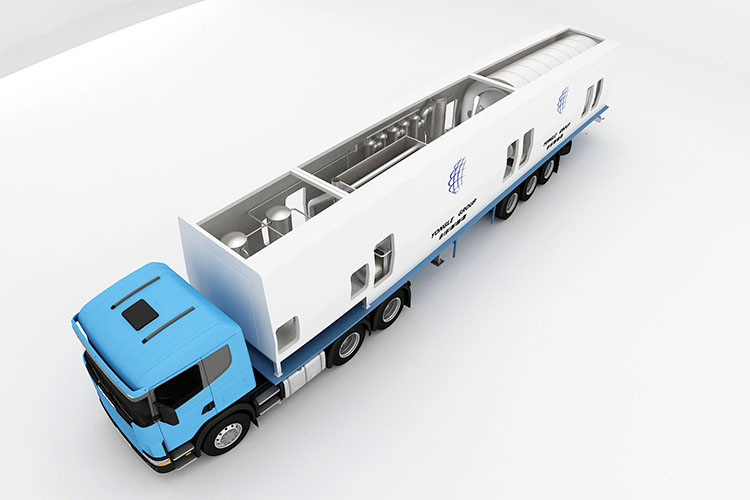Medical waste vehicle mounted processing equipment is a mobile processing system that integrates multiple advanced technologies, capable of immediate processing at medical waste generation sites, greatly improving the efficiency and safety of medical waste management. The equipment consists of a crushing device, a high-temperature disinfection device, a deodorization system, a sewage treatment system, and an operation control system. All parts work together to achieve harmless treatment of medical waste.
Firstly, the crushing device is one of the important components of the medical waste vehicle mounted processing equipment. There are various types of medical waste, including needles, cotton swabs, surgical knives, plastic products, glassware, etc. These wastes come in different shapes and are difficult to handle directly. The crushing device crushes these wastes into small pieces through mechanical force, making it easier for subsequent disinfection and treatment. After crushing, the volume of medical waste is greatly reduced and the surface area is increased, which is conducive to the uniform contact between disinfectant and heat, thereby improving the disinfection effect.

The high-temperature disinfection device is the core part of the entire treatment system. Medical waste contains a large amount of pathogenic microorganisms, which pose a serious threat to the environment and human health if not thoroughly disinfected. High temperature disinfection devices usually use steam sterilization or dry heat sterilization methods to thoroughly kill pathogens in waste through high temperature and high pressure. Steam sterilization is currently one of the most widely used methods. Its principle is to use high-temperature saturated steam to perform high-temperature and high-pressure treatment on waste in a closed environment. Usually, the sterilization effect can be achieved after 15-30 minutes of treatment at 121 ℃ and 103.4kPa. Dry heat sterilization is the use of hot air for high-temperature treatment of waste, suitable for some waste that is not suitable for steam sterilization.
The deodorization system is designed to prevent the pollution of the environment by odorous gases generated during the treatment process. Medical waste generates a large amount of gas during high-temperature treatment. If these gases are directly discharged without treatment, they can cause pollution to the surrounding environment and even cause discomfort and health problems. Deodorization systems treat these gases through physical, chemical, or biological methods, including activated carbon adsorption, ozone oxidation, and biological filtration. Activated carbon adsorption is the use of the porous structure of activated carbon to adsorb organic compounds in gases, achieving the goal of purifying the air; Ozone oxidation is the process of decomposing odorous molecules into harmless substances through the oxidation of ozone; Biofiltration is the use of microorganisms to degrade organic pollutants in gases.

The sewage treatment system is designed to treat the wastewater generated during the medical waste treatment process. These wastewater may contain a large amount of pathogenic microorganisms and harmful chemicals. If not treated and discharged directly, it will cause serious pollution to water bodies and soil. Wastewater treatment systems typically include physical, chemical, and biological treatment methods. The main physical treatment methods are to remove suspended solids in wastewater through filtration, precipitation, and other means; The chemical treatment method involves adding chemicals to cause harmful substances in wastewater to undergo chemical reactions, producing harmless or easily removable substances; The biological treatment method utilizes microorganisms to degrade organic matter in wastewater, achieving the goal of purifying water quality.
The operation control system is the "brain" of the entire vehicle mounted processing equipment, responsible for coordinating and controlling the work of various parts. Modern medical waste vehicle mounted processing equipment usually adopts a fully automated control system, which monitors and adjusts the parameters of each processing link in real time through sensors and control software, ensuring the safety, efficiency, and stability of the processing process. The operation control system also has fault detection and alarm functions. Once an abnormality occurs in the equipment, the system will automatically alarm and take corresponding measures to ensure the safety and reliability of the processing. In addition, the operation control system can also record and store processed data for future monitoring and management.

The integration and mobility of medical waste vehicle mounted processing equipment make it have important application prospects in modern medical waste management. Especially in emergency response and public health emergencies, this equipment can quickly reach the waste generation site for immediate processing, effectively preventing the spread of pathogenic microorganisms and the expansion of pollution. At the same time, in remote areas and places with scarce medical resources, this equipment can also provide convenient medical waste disposal services, significantly improving the local level of medical waste management.
Overall, the vehicle mounted medical waste treatment equipment achieves harmless management of medical waste throughout the entire process from generation to treatment through the close coordination of crushing devices, high-temperature disinfection devices, deodorization systems, sewage treatment systems, and operation control systems. Its flexibility, immediacy, and efficiency make it an important technological innovation in the field of modern medical waste treatment.
Yongle Environmental Protection is mainly engaged in the research and development, production and sales of complete sets of technical equipment for organic solid waste disposal and comprehensive utilization. Production and manufacturing, domestic waste treatment equipment, tire pyrolysis equipment, medical waste disposal equipment, hazardous waste disposal equipment, and achieve efficient and comprehensive utilization of resources through independently developed low-temperature anaerobic pyrolysis equipment technology solutions.
Tags:Introduction and advantages of medical waste vehicle mounted processing equipment,medical waste vehicle mounted processing equipment,YONGLE GROUP
 Latest news
Latest news


























